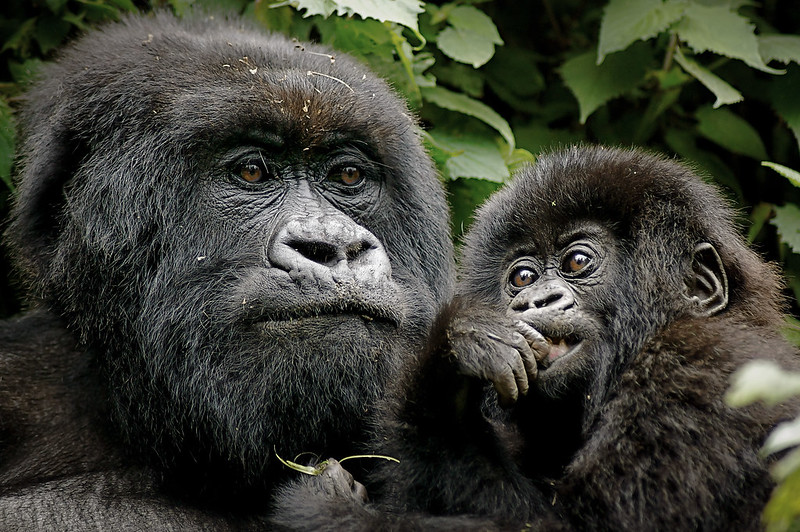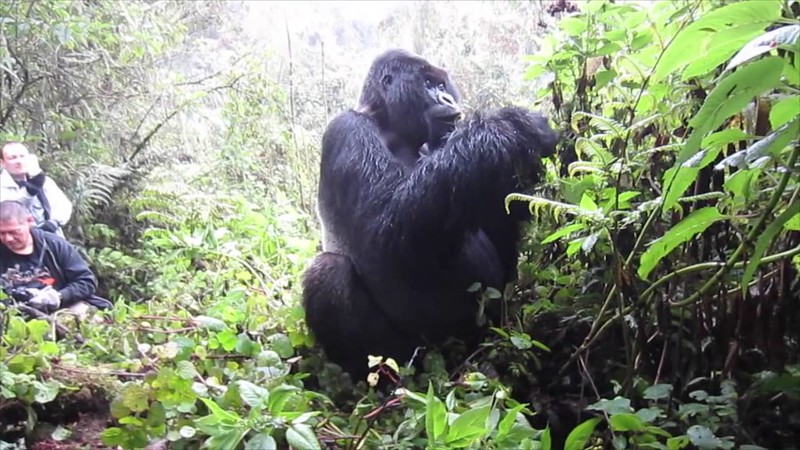If you want to go on a gorilla trekking safari in Uganda or Rwanda, the…
Uganda Leopard safari
Leopard in Uganda
A leopard is considered and believed to be the most mysterious and indefinable animal amongst the large carnivores positioned and located in the wilds. This animal is the most outstanding creature, splendid view to observe for those who get the chance to spot it. These animals (Leopards) are situated and reside in various National Parks in Uganda. They are unsociable creatures and once you capture a chance to spot one then count yourself lucky because they are quiet hard to spot and much less take photos of them.![]()
Leopards are unsociable creatures, infrequently noticed in pairs-they are loners, they also spend much of their days ambling/walking through the Savannah /the forests walloping/hiding in trees. Apart from when mating because that’s the only time you can spot them in pairs. Due to the fact that they do not socialize that much that’s why they don’t reproduce as much and rapid as other animals that stay in groups.
They contain elements and behaviours like being very profligate/fast and silent. Leopards do contain spots on their skins that offers them the ability to cover-up/conceal which enables them hide and too hard to spot. Another reason as to why they are infrequent to spot once on your game drive activity is because they are night-time movers/walkers. ‘Kings of the Jungle’-Lions sometimes do slay/murder Leopards that why they too avoid being near/close to lions and also elude/dodge Hyenas which are so irritating because they snip and steal their kill/prey before the leopard has time to hide it.
Leopards don’t have an exact/specific breeding/reproducing period, they mate any period or time of the year and their gestation period takes about 90-100 days. Leopards (Females) do give birth to 4 cubs and the mother sorts out the best and finest place to look after her cubs well. The death/humanity of these cubs is high, about 50% and those that survive do remain with the mother for over 1-2 hrs and in this life and way they do play with one another, also find out how they do hunt for their own food. Leopard tracks are almost the same as those of a lion, but are minor/slighter with a normal pace distance of roughly 1 m. Leopards are unsociable, but cubs may escort female leopards.
What They Feed On and How They Protect Themselves.
![]() Leopards are very sturdy animals therefore they are proficient/capable of taking down a huge prey, one that is even 3 times bigger/larger. Leopards are also good at swimming, and that is why they can easily hunt for fish, the reptiles, the insects & any other animals in the water and those eating near the water body. They also do feed on domestic animals like the sheep, goats, pigs & the birds like the chicken if they happen to be close to a community.
Leopards are very sturdy animals therefore they are proficient/capable of taking down a huge prey, one that is even 3 times bigger/larger. Leopards are also good at swimming, and that is why they can easily hunt for fish, the reptiles, the insects & any other animals in the water and those eating near the water body. They also do feed on domestic animals like the sheep, goats, pigs & the birds like the chicken if they happen to be close to a community.
Where can one find Leopards in Uganda
These unsociable and silent animals can be located in places mentioned as below.
-
Queen Elizabeth National Park
In this National Park if you desire to spot leopards there is a special place known as Leopard Loop as well as the lovely cat is posed to be positioned in this venturous channel track,Kasenyi Research track around the crater at Queen ‘s Tower/building(currently spotted with a cub here) & by the ancient mating grounds in Kasenyi. Still around Kyambura gorge there exists a resident Leopard. In the southern section of Queen Elizabeth National Park (Ishasha section),transfer to Kigezi Game Reserve/for Ntungwe mating ground but be there in the early morning /late evening if your objective is to spot leopards in Uganda.
-
Murchison Falls National Park
If you have gotten involved in a safari with this National Park inclusive then count yourself lucky to spot Leopards by the Palms towards Tangi gate along Buligi track in the Elephant access strip & by the Park’s track via the sausage tree places.
-
Kidepo Valley National Park
As you proceed to discover this unscathed wilderness, there you will spot Leopards in this Park.
-
Lake Mburo National Park
In this park one should concentrate on the Warukuri track, Zebra track & Lakeside transfer in the evening. There is still a Resident Leopard ground Mihingo lodge & Rwakobo Rock lodge. Still in this park it is possible to spot leopards in the night because there are nigh game drives made in search for the infrequent great cat and leopards.![]()
Other activities that you have to supplement to spotting of Leopards
When it comes to activities in Queen Elizabeth National Park, you can’t exhaust all because they are many. These involve the following
-
Hiking and Nature walks
This is done via the Mweya Peninsular and Maramagambo forest. Here you are permitted to step out of the safari vehicle, bounce your legs meanwhile as you relish the sounds and smell of the park’s wilds.
-
Birding
This activity mainly takes places when you tour Kyambura Gorge. Also normally done during your Boat cruise at the Kazinga channel. According to the Birding International, they chose out Queen Elizabeth National Park as an important Birding Area. Queen has gotten over 619 bird species. The thick vegetation which is related to Uganda and Congo has permitted you to watch and find out both the eastern and central African birds.
- Game Drives
This activity in Queen Elizabeth National Park can either be done/performed during day so that you are able to have a wide view of various animals in the park or at night to have a sight at nocturnal animals like Leopards, Lions, Bush babies, etc.
-
Chimpanzee Trekking
Another exciting activity one should get engaged in and it is mainly carried out in the Kyambura Gorge at a cost of $50 a permit, here you will get chance to spot the familiarized Chimpanzee families and others mammals/animals like Red tailed monkeys,Baboons,Black & White monkeys,etc.

